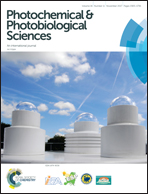A calibrated UV-LED based light source for water purification and characterisation of photocatalysis†
Abstract
Photocatalysis has a potential to become a cost effective industrial process for water cleaning. One of the most studied photocatalysts is titanium dioxide which, as a wide band gap semiconductor, requires ultraviolet (UV) light for its photoactivation. This is at the wavelengths where the efficiency of present-day light emitting diodes (LEDs) decreases rapidly, which presents a challenge in the use of UV-LEDs for commercially viable photocatalysis. There is also a need for accurate photocatalysis measurement of remediation rates of water-borne contaminants for determining optimum exposure doses in industrial applications. In response to these challenges, this paper describes a UV-LED based photocatalytic test reactor that provides a calibrated adjustable light source and pre-defined test conditions to remove as many sources of uncertainty in photocatalytic analysis as possible and thereby improve data reliability. The test reactor provides a selectable intensity of up to 1.9 kW m−2 at the photocatalyst surface. The comparability of the results is achieved through the use of pre-calibration and control electronics that minimize the largest sources of uncertainty; most notably variations in the intensity and directionality of the UV light emission of LEDs and in LED device heating.



 Please wait while we load your content...
Please wait while we load your content...